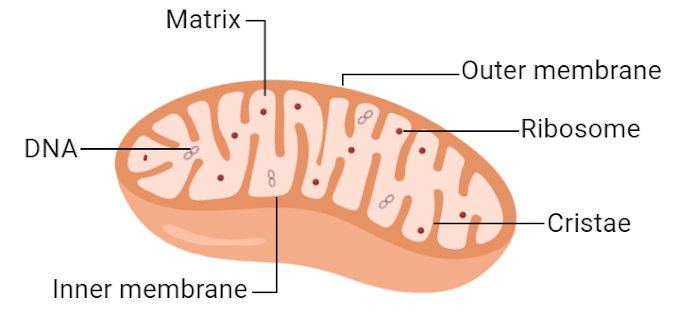
Mitochondria — the “Powerhouses of the Cell”
How they work, what their structure means for biology, and why mitochondrial failure underlies so many diseases
Overview
Mitochondria are membrane-bound organelles within almost all eukaryotic cells. They generate most of the cell’s usable chemical energy (ATP), regulate redox and metabolic signaling, coordinate calcium dynamics, and influence cellular form and fate. A clear primer is available in Britannica’s overview. Deeper biochemical context is covered by the NCBI Bookshelf chapter on mitochondria.
Structure & Location
Mitochondria have a double-membrane architecture: an outer membrane and a highly folded inner membrane (the cristae) that houses the electron transport chain and ATP synthase. Many core metabolic reactions occur in the matrix. For structural detail, see the NCBI chapter on mitochondrial structure and this review on cristae remodeling and function (BMC Biology).
Abundance and positioning vary by tissue and energetic demand; e.g., muscle fibers and neurons have especially dense and elaborated mitochondrial networks. Introductory placement/context is summarized here: BYJU’S – Mitochondria.
Pronunciation & Etymology
Pronunciation: mitochondria (plural) /ˌmaɪtəˈkɒndrɪə/; mitochondrion (singular) /ˌmaɪtəˈkɒndrɪən/.
Etymology: from Greek mitos (thread) + chondros (granule). The term “mitochondria” was coined by Carl Benda (1898). See a quick etymology note here: Vedantu.
Key Functions
1) ATP production and energy conversion
Electrons from nutrients flow through the electron transport chain (ETC) embedded in the inner membrane, pumping protons to generate the membrane potential (ΔΨm). Protons re-enter through ATP synthase to produce ATP. Detailed mechanisms: NCBI Bookshelf.
2) Metabolic integration
Mitochondria supply acetyl-CoA, handle fatty-acid β-oxidation and amino-acid catabolism, and maintain redox currency (NAD⁺/NADH, FAD/FADH₂), shaping the entire cell’s chemistry. See the same NCBI chapter for a thorough review.
3) Signaling and cell fate
They regulate apoptosis, generate reactive oxygen species (ROS) as signaling molecules, and buffer calcium. A lay-accessible overview is available at Medical News Today: What do mitochondria do?.
4) Morphology and networks
Mitochondria continuously fuse and divide, forming dynamic networks whose topology correlates with function and health. A primer on how structure supports function is here: Research Outreach.
Why Mitochondrial Dysfunction Is a Common Root of Disease
Because almost all cellular processes depend on mitochondrial outputs, dysfunction has system-wide effects:
- Energy deficit: Low ATP undermines maintenance/repair and ion pumping.
- Redox imbalance: Distorted NAD⁺/NADH and excessive ROS damage DNA, proteins, and lipids.
- Metabolic misrouting: Substrates divert toward less efficient or toxic pathways.
- Structural collapse: Fragmented networks and altered cristae correlate with loss of polarity and viability.
- Tissue specificity: High-demand tissues (brain, heart, muscle) exhibit distinct failure phenotypes as mitochondrial capacity falters.
For historical grounding in oxidative phosphorylation and disease connections, see this open-access historical perspective: Lehninger and the mitochondrion (PNAS/PMC).
Discovery & Historical Milestones
- 1857 — Albert von Kölliker described granules in muscle that correspond to mitochondria (historical survey: Bitesize Bio).
- 1898 — Carl Benda coined the term “mitochondria” (Vedantu).
- Mid-20th century — Oxidative phosphorylation localized to mitochondria; see this PNAS retrospective.
References
- Britannica — Mitochondrion overview: https://www.britannica.com/science/mitochondrion
- NCBI Bookshelf — Mitochondria (biochemistry & function): https://www.ncbi.nlm.nih.gov/books/NBK26894/
- NCBI Bookshelf — Organelle structure reference: https://www.ncbi.nlm.nih.gov/books/NBK9896/
- BMC Biology — Cristae remodeling and function: https://bmcbiol.biomedcentral.com/articles/10.1186/s12915-015-0201-x
- Wikimedia Commons — Mitochondrion diagram (SVG): https://upload.wikimedia.org/wikipedia/commons/b/b5/Mitochondrion_mini.svg
- BYJU’S — Mitochondria placement/intro: https://byjus.com/biology/mitochondria/
- Medical News Today — What do mitochondria do? https://www.medicalnewstoday.com/articles/320875
- Research Outreach — Structure–function primer: https://researchoutreach.org/articles/simple-powerhouse-structure-function-mitochondria/
- PNAS (open access on PMC) — Historical perspective: https://pmc.ncbi.nlm.nih.gov/articles/PMC3877752/
- Bitesize Bio — History of cell biology (context for early observations): https://bitesizebio.com/166/history-of-cell-biology/
- Vedantu — Who coined “mitochondria”: https://www.vedantu.com/question-answer/coined-the-term-mitochondria-a-altman-b-benda-c-class-11-biology-cbse-5f706615c8f93c434abc2597
